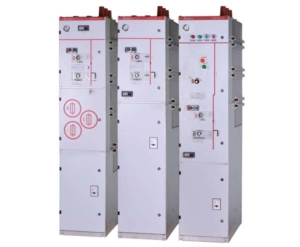Are you one of those people who is searching for answers about the difference between a ring main unit and switchgear?
In that case, we’ve got you covered!
Looking for this answer is now at your own convenience.
In this post, allow us to present you the differences between the two.
Are you ready?
But first, let’s discuss the definition of the two.
What is Ring Main Unit?

Ring main unit is a compact, sealed and enclosed type of switchgear.
These are utilized for medium voltage power distribution.
It’s complete switchgear in itself.
You see,
Complete switchgear simply means, assembly of needed switching devices.
It also includes a protection device and a metering device.
RMU of various voltage and current ratings are accessible too.
Outdoor and indoor types of ring main units are available.

RMU is composed of:
- one incomer feeder and;
- more than one outgoing feeder
You see,
The incomer feeder is either:
- the SF6 circuit breaker or:
- vacuum circuit breaker
with associated earth switch and disconnect switch
Take note that this incomer feeder is presented with the establishment of bushing bulging from the enclosure of RMU for supply cable connection.
What is Switchgear?

Now, what is switchgear?
In an electrical power system, switchgear is the combination of:
- disconnect switches
- circuit breakers or fuses
to control, safeguard and isolate electrical equipment.
Switchgear is utilized both to de-energize equipment.
That will enable work to be performed and to clear faults downstream.
This kind of equipment is directly connected to the reliability of the electrical supply.
What is the Function of RMU?
Normally, an RMU is utilized to enable a fed supply from two directions and tapping of to transformer.
One of these supplies might have a number of ring main units in series creating a ring.
When a section of the feeder requires being isolated because of work or failure, a ring main unit on every end of this area could be opened without obstructing any supply.
What is the Function of a Switchgear?
Meanwhile;
The essential functions of switchgear are:
- Control of circuits
It controls the circuit for functional switching.
- Isolation
It isolates the faulty equipment from the rest of the circuit
- Protection
It safeguards the electrical circuit from earth fault currents, short circuit current faults, and overload.
Advantages of Ring Main Unit
A ring main unit is no doubt a ground-breaking solution.
That makes it a lot simpler to handle the various challenges of electrical distribution.
You see,
RMU is considered an all-in-one solution.
It’s also safe, simple to install and maintenance free switchgear.
It helps the utilities enhance uptime and reliability of the network.
It also lessens operational expenses.
- Smart Capabilities
If fitted along with Intelligent Electronic Devices, a ring main unit is simple to integrate.
- Safety & Performance
In case you didn’t know yet, the latest technology and compact design of the ring main unit guarantee total efficiency, reliability, connectivity, and safety.
- Cost & Time Savings
A ring main unit is a switchgear and is simple to install.
If you use this, you can expect to save in commission and installation time.
What’s more;
A ring main unit is also independent of climate.
They are resistant to any environmental conditions.
The maintenance and operation expenses of such units are low as well.
- Feature-Rich Compact Designs
Ultimately, RMU is an SF6 insulated compact switchgear.
It is geared with a vacuum circuit breaker and an SF6 switch disconnector.
Its compact design needs the least possible space to set up and operate.
In the modern power distribution system, RMU is widely utilized across the globe.
They are used to meet the growing necessity of reliable energy.
It is one solution along with comprehensive capabilities.
Advantages of a Switchgear
Some of the essential features of switchgear include:
- Provision for manual control
- Quick operation
- Complete reliability
- Certain discrimination
Below, we will discuss each of them:
- Provision for manual control
Switchgear should have provision for manual control.
In case the electrical control fails, the needed operation could be performed with manual control.
- Fast operation
If a fault happens on any portion of the power system, the switchgear should run faster.
That’s to ensure that no damage is done to transformers, generators and other equipment.
When the fault isn’t cleared quickly, it’s likely to spread into healthy areas.
Therefore, it endangers a total shut down of the system.
- Certain discrimination
When a fault takes place on any area of the power system, your switchgear should discriminate between the healthy and faulty section.
It must isolate the faulty area from the system without influencing the healthy area.
That will guarantee continuity supply.
- Total reliability
The demand for dependable switchgear has become utmost importance along with the:
- the rising capacity of generating stations and;
- the continued trend of interconnection
That isn’t surprising anymore, as it’s included in the power system to enhance reliability.
If a fault takes place on any portion of the system, it must run to isolate the faulty area from the remaining circuit.
At this moment, we hope you already identified the major differences between RMU and switchgear.
In short:
Ring main unit is utilized in a substation in a high voltage distribution.
An example of this is an 11kV or above.
It is a ring system where one line is interrupted or fails, the other will work.
